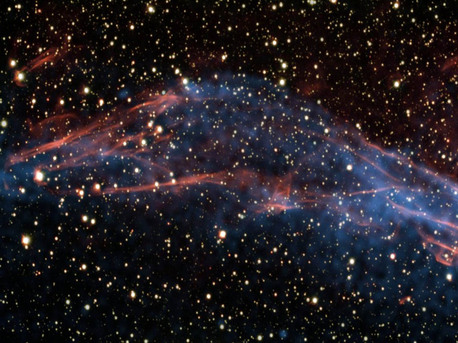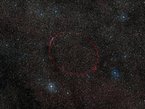Milky Way News
Milky Way's super-efficient particle accelerators in action
 © ESO/E. Helder & NASA/Chandra
|
Image of part of a stellar remnant whose explosion was recorded in 185 AD. By studying this remnant in detail, a team of astronomers was able to solve the mystery of the Milky Way’s super-efficient particle accelerators. North is toward the top right and east to the top left. The image is about 6 arc minutes across.
Galactic cosmic rays come from sources inside our home galaxy, the Milky Way, and consist mostly of protons moving at close to the speed of light, the “ultimate speed limit” in the Universe. These protons have been accelerated to energies exceeding by far the energies that even CERN’s Large Hadron Collider will be able to achieve.
“It has long been thought that the super-accelerators that produce these cosmic rays in the Milky Way are the expanding envelopes created by exploded stars, but our observations reveal the smoking gun that proves it”, says Eveline Helder from the Astronomical Institute Utrecht of Utrecht University in the Netherlands, the first author of the new study.
“You could even say that we have now confirmed the caliber of the gun used to accelerate cosmic rays to their tremendous energies”, adds collaborator Jacco Vink, also from the Astronomical Institute Utrecht.
For the first time Helder, Vink and colleagues have come up with a measurement that solves the long-standing astronomical quandary of whether or not stellar explosions produce enough accelerated particles to explain the number of cosmic rays that hit the Earth’s atmosphere. The team’s study indicates that they indeed do and it directly tells us how much energy is removed from the shocked gas in the stellar explosion and used to accelerate particles.
“When a star explodes in what we call a supernova a large part of the explosion energy is used for accelerating some particles up to extremely high energies”, says Helder. “The energy that is used for particle acceleration is at the expense of heating the gas, which is therefore much colder than theory predicts”.
The researchers looked at the remnant of a star that exploded in AD 185, as recorded by Chinese astronomers. The remnant, called RCW 86, is located about 8200 light-years away towards the constellation of Circinus (the Drawing Compass). It is probably the oldest record of the explosion of a star.
Using ESO’s Very Large Telescope, the team measured the temperature of the gas right behind the shock wave created by the stellar explosion. They measured the speed of the shock wave as well, using images taken with NASA’s X-ray Observatory Chandra three years apart. They found it to be moving at between 10 and 30 million km/h, between 1 and 3 percent the speed of light.
The temperature of the gas turned out to be 30 million degrees Celsius. This is quite hot compared to everyday standards, but much lower than expected, given the measured shock wave’s velocity. This should have heated the gas up to at least half a billion degrees.
“The missing energy is what drives the cosmic rays”, concludes Vink.
ESO
Milky Way News
Milky Way's super-efficient particle accelerators in action
 © ESO/E. Helder & NASA/Chandra
|
Image of part of a stellar remnant whose explosion was recorded in 185 AD. By studying this remnant in detail, a team of astronomers was able to solve the mystery of the Milky Way’s super-efficient particle accelerators. North is toward the top right and east to the top left. The image is about 6 arc minutes across.
Galactic cosmic rays come from sources inside our home galaxy, the Milky Way, and consist mostly of protons moving at close to the speed of light, the “ultimate speed limit” in the Universe. These protons have been accelerated to energies exceeding by far the energies that even CERN’s Large Hadron Collider will be able to achieve.
“It has long been thought that the super-accelerators that produce these cosmic rays in the Milky Way are the expanding envelopes created by exploded stars, but our observations reveal the smoking gun that proves it”, says Eveline Helder from the Astronomical Institute Utrecht of Utrecht University in the Netherlands, the first author of the new study.
“You could even say that we have now confirmed the caliber of the gun used to accelerate cosmic rays to their tremendous energies”, adds collaborator Jacco Vink, also from the Astronomical Institute Utrecht.
For the first time Helder, Vink and colleagues have come up with a measurement that solves the long-standing astronomical quandary of whether or not stellar explosions produce enough accelerated particles to explain the number of cosmic rays that hit the Earth’s atmosphere. The team’s study indicates that they indeed do and it directly tells us how much energy is removed from the shocked gas in the stellar explosion and used to accelerate particles.
“When a star explodes in what we call a supernova a large part of the explosion energy is used for accelerating some particles up to extremely high energies”, says Helder. “The energy that is used for particle acceleration is at the expense of heating the gas, which is therefore much colder than theory predicts”.
The researchers looked at the remnant of a star that exploded in AD 185, as recorded by Chinese astronomers. The remnant, called RCW 86, is located about 8200 light-years away towards the constellation of Circinus (the Drawing Compass). It is probably the oldest record of the explosion of a star.
Using ESO’s Very Large Telescope, the team measured the temperature of the gas right behind the shock wave created by the stellar explosion. They measured the speed of the shock wave as well, using images taken with NASA’s X-ray Observatory Chandra three years apart. They found it to be moving at between 10 and 30 million km/h, between 1 and 3 percent the speed of light.
The temperature of the gas turned out to be 30 million degrees Celsius. This is quite hot compared to everyday standards, but much lower than expected, given the measured shock wave’s velocity. This should have heated the gas up to at least half a billion degrees.
“The missing energy is what drives the cosmic rays”, concludes Vink.
ESO









